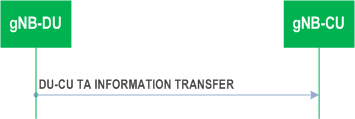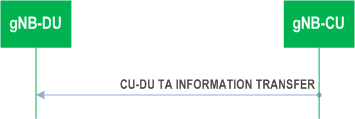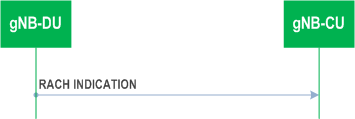Content for TS 38.473 Word version: 18.2.0
8.2.6 gNB-DU Resource Coordination
8.2.7 gNB-DU Status Indication
8.2.8 F1 Removal
8.2.9 Network Access Rate Reduction
8.2.10 Resource Status Reporting Initiation
8.2.11 Resource Status Reporting
8.2.12 DU-CU TA Information Transfer
8.2.13 CU-DU TA Information Transfer
8.2.14 RACH Indication
...
...
8.2.6 gNB-DU Resource Coordination p. 43
8.2.6.1 General p. 43
The purpose of the gNB-DU Resource Coordination procedure is to enable coordination of radio resource allocation between a gNB-CU and a gNB-DU for the purpose of spectrum sharing between E-UTRA and NR. This procedure is to be used only for the purpose of spectrum sharing between E-UTRA and NR.
The procedure uses non-UE-associated signalling.
8.2.6.2 Successful Operation p. 44

A gNB-CU initiates the procedure by sending the GNB-DU RESOURCE COORDINATION REQUEST message to a gNB-DU over the F1 interface.
The gNB-DU extracts the E-UTRA - NR Cell Resource Coordination Request Container IE and it replies by sending the GNB-DU RESOURCE COORDINATION RESPONSE message.
In case of NR-initiated gNB-DU Resource Coordination procedure, the Ignore Coordination Request Container IE shall be present and set to "yes" and the E-UTRA - NR Cell Resource Coordination Request Container IE in the GNB-DU RESOURCE COORDINATION REQUEST message shall be ignored.
8.2.7 gNB-DU Status Indication p. 44
8.2.7.1 General p. 44
The purpose of the gNB-DU Status Indication procedure is informing the gNB-CU that the gNB-DU is overloaded so that overload reduction actions can be applied. This procedure is also used to inform the IAB-donor-CU about a downlink congestion at an IAB-DU or an IAB-donor-DU. The procedure uses non-UE associated signalling.
8.2.7.2 Successful Operation p. 44

If the gNB-DU Overload Information IE in the GNB-DU STATUS INDICATION message indicates that the gNB-DU is overloaded, the gNB-CU shall apply overload reduction actions until informed, with a new GNB-DU STATUS INDICATION message, that the overload situation has ceased.
The detailed overload reduction policy is up to gNB-CU implementation.
If the gNB-DU is an IAB-DU or an IAB-donor-DU, and if the IAB Congestion Indication IE is present in the GNB-DU STATUS INDICATION message and only includes the Child Node Identifier IE, the gNB-CU shall, if supported, consider that the backhaul link between the gNB-DU and the node identified by the Child Node Identifier IE is congested. If the IAB Congestion Indication IE is present in the GNB-DU STATUS INDICATION message and includes both the Child Node Identifier IE and the BH RLC CH ID IE, the gNB-CU shall, if supported, consider that congestion occurs on the corresponding BH RLC channel(s) over the link towards the node identified by the Child Node Identifier IE.
8.2.7.3 Abnormal Conditions p. 45
Void.
8.2.8 F1 Removal p. 45
8.2.8.1 General p. 45
The purpose of the F1 Removal procedure is to remove the interface instance and all related resources between the gNB-DU and the gNB-CU in a controlled manner. If successful, this procedure erases any existing application level configuration data in the two nodes.
The procedure uses non-UE-associated signaling.
8.2.8.2 Successful Operation p. 45


Successful F1 Removal, gNB-DU initiated
The gNB-DU initiates the procedure by sending the F1 REMOVAL REQUEST message to the gNB-CU. Upon reception of the F1 REMOVAL REQUEST message the gNB-CU shall reply with the F1 REMOVAL RESPONSE message. After receiving the F1 REMOVAL RESPONSE message, the gNB-DU may initiate removal of the TNL association towards the gNB-CU, if applicable, and may remove all resources associated with that interface instance. The gNB-CU may then remove all resources associated with that interface instance.
Successful F1 Removal, gNB-CU initiated
The gNB-CU initiates the procedure by sending the F1 REMOVAL REQUEST message to the gNB-DU. Upon reception of the F1 REMOVAL REQUEST message the gNB-DU shall reply with the F1 REMOVAL RESPONSE message. After receiving the F1 REMOVAL RESPONSE message, the gNB-CU may initiate removal of the TNL association towards the gNB-DU, if applicable, and may remove all resources associated with that interface instance. The gNB-DU may then remove all resources associated with that interface instance.
8.2.8.3 Unsuccessful Operation p. 46


Unsuccessful F1 Removal, gNB-DU initiated
If the gNB-CU cannot accept to remove the interface instance with the gNB-DU it shall respond with an F1 REMOVAL FAILURE message with an appropriate cause value.
Unsuccessful F1 Removal, gNB-CU initiated
If the gNB-DU cannot accept to remove the interface instance with the gNB-CU it shall respond with an F1 REMOVAL FAILURE message with an appropriate cause value.
8.2.8.4 Abnormal Conditions p. 46
Not applicable.
8.2.9 Network Access Rate Reduction p. 46
8.2.9.1 General p. 46
The purpose of the Network Access Rate Reduction procedure is to indicate to the gNB-DU that the rate at which UEs are accessing the network need to be reduced from its current level.
The procedure uses non-UE associated signalling.
8.2.9.2 Successful operation p. 47

The gNB-CU initiates the procedure by sending a NETWORK ACCESS RATE REDUCTION message to the gNB-DU. When receiving the NETWORK ACCESS RATE REDUCTION message the gNB-DU should take into account the information contained in the UAC Assistance Information IE to set the parameters for Unified Access Barring.
If the NID IE is contained in the NETWORK ACCESS RATE REDUCTION message, the gNB-DU should take it into account and combine the NID IE with the PLMN Identity IE to identify the SNPN.
8.2.9.3 Abnormal Conditions p. 47
Not applicable
8.2.10 Resource Status Reporting Initiation |R16| p. 47
8.2.10.1 General p. 47
This procedure is used by an gNB-CU to request the reporting of load measurements to gNB-DU.
The procedure uses non UE-associated signalling.
8.2.10.2 Successful Operation p. 47

gNB-CU initiates the procedure by sending the RESOURCE STATUS REQUEST message to gNB-DU to start a measurement, stop a measurement, or add cells to report for a measurement. Upon receipt, gNB-DU:
When starting a measurement, the Report Characteristics IE in the RESOURCE STATUS REQUEST indicates the type of objects gNB-DU shall perform measurements on. For each cell, gNB-DU shall include in the RESOURCE STATUS UPDATE message:
- shall initiate the requested measurement according to the parameters given in the request in case the Registration Request IE set to "start"; or
- shall stop all cells measurements and terminate the reporting in case the Registration Request IE is set to "stop"; or
- shall add cells indicated in the Cell To Report List IE to the measurements initiated before for the given measurement IDs, in case the Registration Request IE is set to "add". If measurements are already initiated for a cell indicated in the Cell To Report List IE, this information shall be ignored.
- the Radio Resource Status IE, if the first bit, "PRB Periodic" of the Report Characteristics IE included in the RESOURCE STATUS REQUEST message is set to 1. If the cell for which Radio Resource Status IE is requested to be reported supports more than one SSB, the Radio Resource Status IE for such cell shall include the SSB Area Radio Resource Status Item IE for all SSB areas supported by the cell. If the SSB To Report List IE is included for a cell, the Radio Resource IE for such cell shall only include the SSB Area Radio Resource Status List IE; If the cell for which Radio Resource Status IE is requested to be reported supports more than one slice, and if the Slice To Report List IE is included for a cell, the Radio Resource Status IE for such cell shall, if supported, include the requested Slice Radio Resource Status Item IE; If the cell for which Radio Resource Status IE is requested to be reported supports MIMO the Radio Resource Status IE for such cell may include the MIMO PRB usage Information IE;
- the TNL Capacity Indicator IE, if the second bit, "TNL Capacity Ind Periodic" of the Report Characteristics IE included in the RESOURCE STATUS REQUEST message is set to 1;
- the Composite Available Capacity Group IE, if the third bit, "Composite Available Capacity Periodic" of the Report Characteristics IE included in the RESOURCE STATUS REQUEST message is set to 1. If Cell Capacity Class Value IE is included within the Composite Available Capacity Group IE, this IE is used to assign weights to the available capacity indicated in the Capacity Value IE. If the cell for which Composite Available Capacity Group IE is requested to be reported supports more than one SSB the Composite Available Capacity Group IE for such cell shall include the SSB Area Capacity Value List IE for all SSB areas supported by the cell, providing the SSB area capacity with respect to the Cell Capacity Class Value IE. If the SSB To Report List IE is included for a cell, the Composite Available Capacity Group IE for such cell shall include the requested SSB Area Capacity Value List IE providing the SSB area capacity with respect to the Cell Capacity Class Value. If the cell for which Composite Available Capacity Group IE is requested to be reported supports more than one slice, and if the Slice To Report List IE is included for a cell, the Slice Available Capacity IE for such cell shall include the requested Slice Available Capacity Value Downlink IE and Slice Available Capacity Value Uplink IE, providing the slice capacity with respect to the Cell Capacity Class Value.
- the Hardware Load Indicator IE, if the fourth bit, "HW LoadInd Periodic" of the Report Characteristics IE included in the RESOURCE STATUS REQUEST message is set to 1;
- the Number of Active UEs IE, if the fifth bit, "Number of Active UEs Periodic" of the Report Characteristics IE included in the RESOURCE STATUS REQUEST message is set to 1;
- the NR-U Channel List IE, if the sixth bit, " NR-U Channel List Periodic" of the Report Characteristics IE included in the RESOURCE STATUS REQUEST message is set to "1".
8.2.10.3 Unsuccessful Operation p. 49

If any of the requested measurements cannot be initiated, gNB-DU shall send the RESOURCE STATUS FAILURE message with an appropriate cause value.
8.2.10.4 Abnormal Conditions p. 49
If the initiating gNB-CU does not receive either RESOURCE STATUS RESPONSE message or RESOURCE STATUS FAILURE message, the gNB-CU may reinitiate the Resource Status Reporting Initiation procedure towards the same gNB-DU, provided that the content of the new RESOURCE STATUS REQUEST message is identical to the content of the previously unacknowledged RESOURCE STATUS REQUEST message with the same Transaction ID.
If the Report Characteristics IE bitmap is set to "0" (all bits are set to "0") in the RESOURCE STATUS REQUEST message then gNB-DU shall initiate a RESOURCE STATUS FAILURE message with an appropriate cause value.
If the gNB-DU receives a RESOURCE STATUS REQUEST message which includes the Registration Request IE set to "start" and the gNB-CU Measurement ID IE corresponding to an existing on-going load measurement reporting, for which a different Transaction ID is used, then gNB-DU shall initiate a RESOURCE STATUS FAILURE message with an appropriate cause value.
8.2.11 Resource Status Reporting |R16| p. 49
8.2.11.1 General p. 49
This procedure is initiated by gNB-DU to report the result of measurements admitted by gNB-DU following a successful Resource Status Reporting Initiation procedure.
The procedure uses non UE-associated signalling.
8.2.11.2 Successful Operation p. 49

The gNB-DU shall report the results of the admitted measurements in RESOURCE STATUS UPDATE message. The admitted measurements are the measurements that were successfully initiated during the preceding Resource Status Reporting Initiation procedure.
If some results of the admitted measurements in RESOURCE STATUS UPDATE message are missing, the gNB-CU shall consider that these results were not available at the gNB-DU.
8.2.11.3 Unsuccessful Operation p. 50
Not applicable.
8.2.11.4 Abnormal Conditions p. 50
Void.
8.2.12 DU-CU TA Information Transfer |R18| p. 50
8.2.12.1 General p. 50
The purpose of the DU-CU TA Information Transfer procedure is to to enable the gNB-DU to send the TA related information to the gNB-CU. The procedure uses non-UE-associated signalling.
8.2.12.2 Successful Operation p. 50

The gNB-DU initiates the procedure by sending a DU-CU TA Information Transfer message.
Upon reception of the DU-CU TA Information Transfer message, the gNB-CU shall, if supported, consider that the received information is the TA information from the candidate cell(s) that is indicated by the included Candidate Cell ID IE.
If the Tag ID Pointer IE is included, the gNB-CU shall, if supported, consider it to determine the TAG corresponding to the received TA value.
8.2.12.3 Unsuccessful Operation p. 50
Not applicable.
8.2.12.4 Abnormal Conditions p. 50
Not applicable.
8.2.13 CU-DU TA Information Transfer |R18| p. 50
8.2.13.1 General p. 50
The purpose of the CU-DU TA Information Transfer procedure is to to enable the gNB-CU to send the TA related information to the gNB-DU. The procedure uses non-UE-associated signalling.
8.2.13.2 Successful Operation p. 51

The gNB-CU initiates the procedure by sending a CU-DU TA Information Transfer message.
Upon reception of the CU-DU TA Information Transfer message, the gNB-DU shall, if supported, consider that the received information is the TA information from the candidate cell(s) that is indicated by the included Candidate Cell ID IE.
If the Tag ID Pointer IE is included, the gNB-DU shall, if supported, consider it to determine the TAG corresponding to the received TA value.
8.2.13.3 Unsuccessful Operation p. 51
Not applicable.
8.2.13.4 Abnormal Conditions p. 51
Not applicable.
8.2.14 RACH Indication |R18| p. 51
8.2.14.1 General p. 51
This procedure is initiated by the gNB-DU to inform the gNB-CU about the occurrences of successful random access procedures in the gNB-DU.
The procedure uses non-UE-associated signalling.
8.2.14.2 Successful Operation p. 51

The gNB-DU initiates the procedure by sending the RACH INDICATION message to the gNB-CU.
The RACH INDICATION message contains information concerning one or more successful random access procedures occurring at the gNB-DU and not known to the gNB-CU as described in TS 38.401.
Upon reception of the RACH INDICATION message, the gNB-CU may trigger retrieval of RACH Reports from the UE.
8.2.14.3 Abnormal Conditions p. 52
Not applicable.